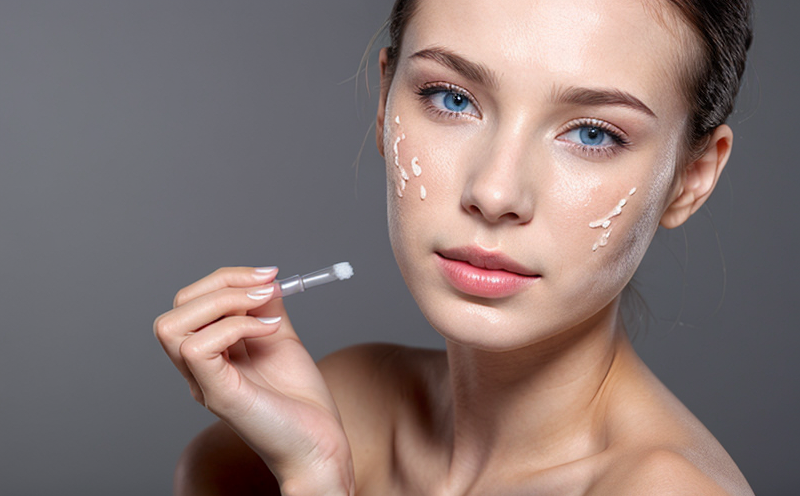OECD TG 406 Skin Sensitization Testing for Cosmetics
The OECD Test Guideline 406 is a comprehensive approach to assessing skin sensitization in cosmetics. This test serves as an essential tool for ensuring the safety of cosmetic products, particularly those that come into direct contact with the skin. The primary objective of this guideline is to evaluate whether a substance or mixture can cause allergic reactions when applied topically.
Underpinning this testing protocol are rigorous international standards such as OECD TG 406 and ISO/IEC 17025, which guarantee the reliability and validity of laboratory results. These guidelines ensure that all tests conducted are not only accurate but also reproducible across different laboratories, thereby enhancing the credibility of the test outcomes.
The process involves exposing guinea pigs to the cosmetic formulation under controlled conditions. The animals are observed for signs of skin irritation over a specified period. This approach is crucial in identifying potential allergens that may cause adverse reactions when used by consumers. It’s important to note that this testing procedure aligns with ethical standards set forth by regulatory bodies, ensuring that animal welfare is prioritized throughout the process.
The significance of OECD TG 406 cannot be overstated, especially given its role in safeguarding public health and promoting responsible product development within the cosmetics industry. By adhering to these stringent protocols, manufacturers can ensure their products meet international safety standards, thereby gaining consumer trust and fostering market competitiveness.
Moreover, compliance with OECD TG 406 is a prerequisite for regulatory approval in many countries worldwide. This includes regions like Europe, where stringent regulations on cosmetic ingredients are enforced. Thus, the implementation of this testing protocol not only protects end-users but also supports the broader goals of sustainable and responsible manufacturing practices.
In summary, OECD TG 406 Skin Sensitization Testing for Cosmetics is a vital component in ensuring the safety and quality of cosmetic products. Its comprehensive approach to identifying potential allergens ensures that consumers are protected while fostering industry best practices.
Applied Standards
| Standard Number | Description |
|---|---|
| OECD TG 406 | Test Guideline for Skin Sensitization Testing of Cosmetics |
| ISO/IEC 17025 | General Requirements for the Competence of Testing and Calibration Laboratories |
Scope and Methodology
The OECD TG 406 Skin Sensitization Test encompasses a series of procedures designed to assess whether a cosmetic formulation can cause allergic reactions. The test is conducted using guinea pigs, which are widely accepted as suitable models for this type of sensitivity testing due to their physiological similarities with humans.
During the test, groups of animals receive either single or repeated applications of the cosmetic product under controlled conditions. Observations are made daily over a period of up to 14 days to monitor any signs of skin irritation or sensitization. The criteria for determining positive outcomes include increased weight loss, erythema (redness), and edema (swelling).
It’s crucial to follow the prescribed protocols meticulously to ensure accurate results. Any deviations from these guidelines could lead to unreliable data, which may not reflect the true nature of skin sensitization risks associated with the cosmetic product.
The methodology employed in this test aligns closely with internationally recognized standards, ensuring consistency and reliability across different laboratories. This approach is pivotal for maintaining high-quality standards within the cosmetics industry and fostering trust among consumers.
Competitive Advantage and Market Impact
The implementation of OECD TG 406 Skin Sensitization Testing offers significant competitive advantages to cosmetic manufacturers and brands. By adhering to these rigorous testing protocols, companies can demonstrate their commitment to product safety and consumer well-being, thereby enhancing brand reputation and customer loyalty.
Compliance with this guideline also opens doors to international markets where stringent regulations on cosmetics are enforced. This not only facilitates easier market entry but also ensures that products meet the highest safety standards expected by regulatory authorities worldwide. Such alignment can significantly reduce the risk of product recalls or bans, protecting both the brand’s image and its bottom line.
In addition to these benefits, manufacturers who invest in OECD TG 406 Testing can anticipate a broader range of customer segments willing to trust their products. The growing trend towards conscious consumerism means that consumers are increasingly seeking out brands that prioritize safety and ethical practices. By demonstrating compliance with this internationally recognized standard, companies can cater effectively to this demand.
Moreover, the data generated from these tests provides valuable insights into potential allergens within a cosmetic formulation. This information enables manufacturers to make informed decisions about ingredient sourcing and formulation adjustments, ultimately leading to more effective products that meet consumer expectations.
In conclusion, OECD TG 406 Skin Sensitization Testing is not just a regulatory requirement; it’s an opportunity for brands to differentiate themselves in the market through commitment to safety and quality. This approach ensures long-term success by building trust with consumers while meeting international standards.





